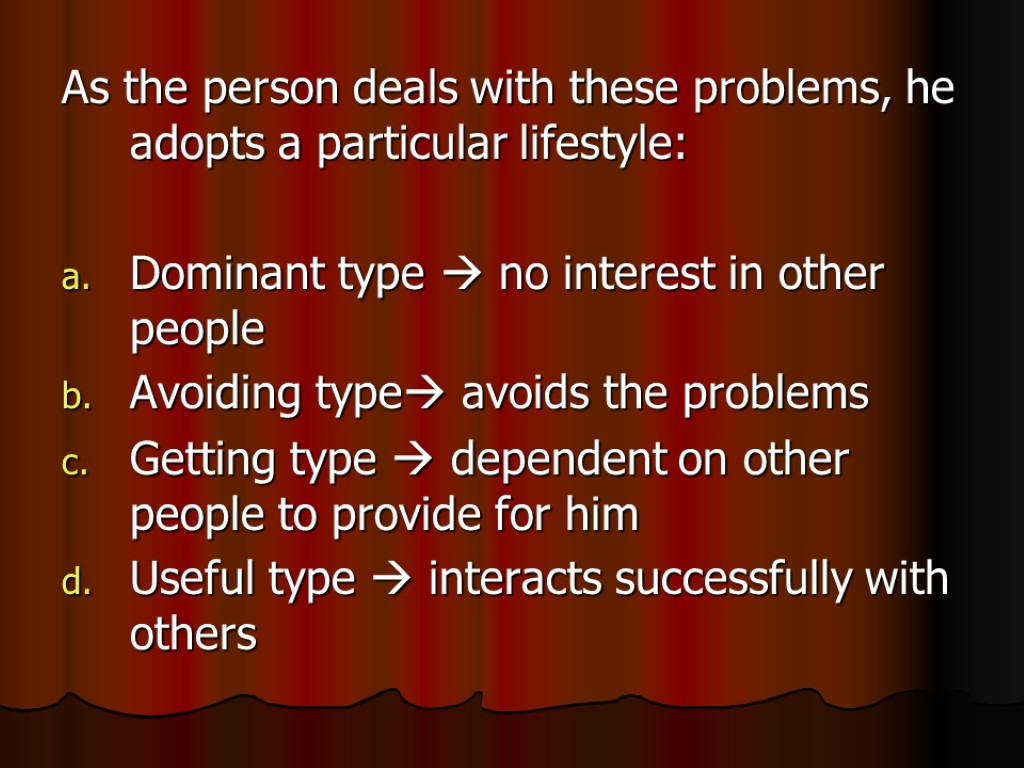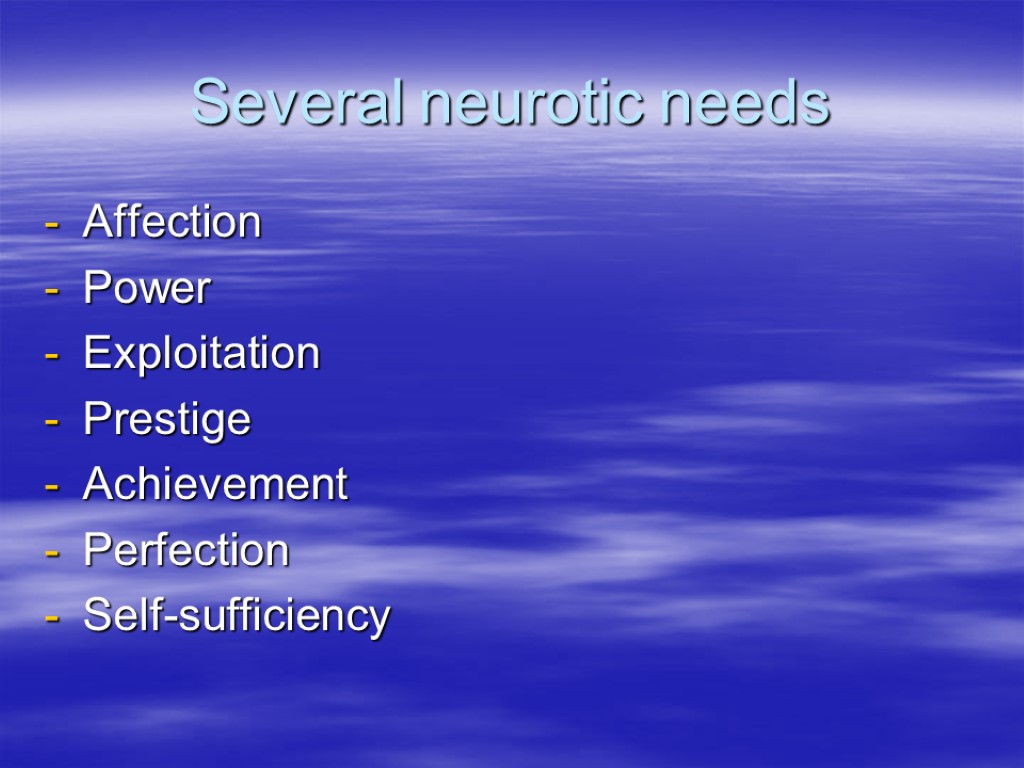 Lecture 2-3. Personality. Psychoanalytic approach Study questions: Lecture 2 What is personality? 3 goals of personality. Personality according to S. Freud. Describe 3 major concepts of psychoanalytic theory: id, superego, ego.
Lecture 2-3. Personality. Psychoanalytic approach Study questions: Lecture 2 What is personality? 3 goals of personality. Personality according to S. Freud. Describe 3 major concepts of psychoanalytic theory: id, superego, ego.
 Lecture 3. 5.Define collective unconscious and archetypes as Jung saw them. 6. What is the aim of a healthy personality according to Jung? 7. Describe the difference between extraverts/introverts, thinking/feeling types. 8. Describe Adler’s concept of personality – a drive for superiority. 9. Identify neurotic needs according to Horney’s Cultural Psychology. 10. What is the problem with the psychoanalytic approach to personality?
Lecture 3. 5.Define collective unconscious and archetypes as Jung saw them. 6. What is the aim of a healthy personality according to Jung? 7. Describe the difference between extraverts/introverts, thinking/feeling types. 8. Describe Adler’s concept of personality – a drive for superiority. 9. Identify neurotic needs according to Horney’s Cultural Psychology. 10. What is the problem with the psychoanalytic approach to personality?
 Personality The core of psychology Distinctive patterns of behavior/cognition that characterize a person’s adaptation to life. Made up of one’s public behaviors, private motives, thoughts, emotions, interactions.
Personality The core of psychology Distinctive patterns of behavior/cognition that characterize a person’s adaptation to life. Made up of one’s public behaviors, private motives, thoughts, emotions, interactions.
 3 goals of personality To organize the characteristics of personality ( aggressiveness, emotionality, intelligence, sociability, anxiousness, passivity) To explain personality variability (differences and similarities among individuals) To describe the normal, healthy personality.
3 goals of personality To organize the characteristics of personality ( aggressiveness, emotionality, intelligence, sociability, anxiousness, passivity) To explain personality variability (differences and similarities among individuals) To describe the normal, healthy personality.
 Personality theories Psychoanalytic (Freud, Jung, Adler, Horney) Humanistic (C. Rogers, A. Maslow) Behavioral (Skinner) Social –learning ( J. Rotter) Trait (G. Allport, Cattel, Eysenck)
Personality theories Psychoanalytic (Freud, Jung, Adler, Horney) Humanistic (C. Rogers, A. Maslow) Behavioral (Skinner) Social –learning ( J. Rotter) Trait (G. Allport, Cattel, Eysenck)
 Psychoanalytic theory of Sigmund Freud.
Psychoanalytic theory of Sigmund Freud.
 The id instincts, unconscious animal urges I want The superego ethical and moral values of a person’s family and culture I should The ego conscious awareness of the conflict between id and superego I can
The id instincts, unconscious animal urges I want The superego ethical and moral values of a person’s family and culture I should The ego conscious awareness of the conflict between id and superego I can
 Jung’s analytical theory Personal unconscious + collective unconscious Repressed thoughts and memories universal human experience (archetypes)
Jung’s analytical theory Personal unconscious + collective unconscious Repressed thoughts and memories universal human experience (archetypes)
 The aim of a healthy personality individuation To achieve a kind of wholeness where all parts of personality are fully developed
The aim of a healthy personality individuation To achieve a kind of wholeness where all parts of personality are fully developed
 Ego : conscious mind provides stability concerned with thinking emotion, memory, perception. 2 attitudes to control ego: extraversion or introversion. 4 functions how people deal with the world: thinking feeling sensing intuiting.
Ego : conscious mind provides stability concerned with thinking emotion, memory, perception. 2 attitudes to control ego: extraversion or introversion. 4 functions how people deal with the world: thinking feeling sensing intuiting.
 Adler’s Individual Psychology Every person is unique and motivated By a drive for superiority (inferiority/superiority complex) 2) Every person must solve life problems in the areas: Interacting with others Having an occupation Being in love
Adler’s Individual Psychology Every person is unique and motivated By a drive for superiority (inferiority/superiority complex) 2) Every person must solve life problems in the areas: Interacting with others Having an occupation Being in love
 As the person deals with these problems, he adopts a particular lifestyle: Dominant type no interest in other people Avoiding type avoids the problems Getting type dependent on other people to provide for him Useful type interacts successfully with others
As the person deals with these problems, he adopts a particular lifestyle: Dominant type no interest in other people Avoiding type avoids the problems Getting type dependent on other people to provide for him Useful type interacts successfully with others
 Horney’s cultural Psychology Importance of social and cultural influences 2 basic needs in childhood: safety and satisfaction, if they are not met basic anxiety To protect from basic anxiety the person attempts to To gain love from others Complies with wishes of others Gains power over other
Horney’s cultural Psychology Importance of social and cultural influences 2 basic needs in childhood: safety and satisfaction, if they are not met basic anxiety To protect from basic anxiety the person attempts to To gain love from others Complies with wishes of others Gains power over other
 Several neurotic needs Affection Power Exploitation Prestige Achievement Perfection Self-sufficiency
Several neurotic needs Affection Power Exploitation Prestige Achievement Perfection Self-sufficiency
 Ways of adapting/neurotic trends Compliant personality moving towards people Aggressive personality moving against people Detached personality moving away people
Ways of adapting/neurotic trends Compliant personality moving towards people Aggressive personality moving against people Detached personality moving away people































